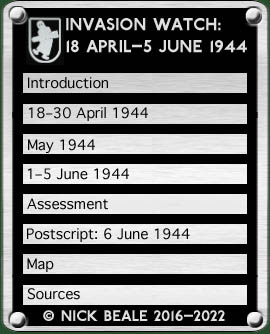
|
||
|
Many historians of the Normandy campaign note that the defenders, although aware that an invasion must come, were nevertheless caught off guard when it actually did. None that I have read goes far into the question, beyond noting the success of Allied deception measures. Admiral Theodor Krancke of Marine-Gruppenkommando West set down his verdict in 1946:
In The Longest Day (1959), Cornelius Ryan took an extreme position: … the Germans remained blind … only a few planes had been sent over the embarkation areas in the preceding weeks, and all had been shot down. Brief investigation shows that Luftwaffe reconnaissance aircraft were not in fact dropping like flies over Southern England in Spring 1944 and Max Hastings (Overlord, 1993) offered a more nuanced observation: Germany’s critical weakness on the Channel coast in the spring of 1944 was her blindness. The Luftwaffe had lost not only its strength but its will. Despite the difficulties posed by Allied command of the air, some measure of air reconnaissance might yet have been possible given real determination by the German airmen. Although his source for this is not clear, Hastings pretty much hits the nail on the head. I would only differ with him about strength — Luftflotte 3 had quite a range of overland reconnaissance assets in Northern France and the Low Countries. Facing the Channel and North Sea in Spring 1944 were:
The Bf 109, the Me 410, the Ju 88 S/T series and the Ju 188 could potentially operate over the British mainland, by day or night as appropriate, and return home. Undoubtedly a sustained effort would have incurred losses but the Luftwaffe did not hesitate to sacrifice men and machines where this seemed necessary to achieve a desired result. The Bf 109 Staffeln carried out similar tasks, despite two being designated Nah- (short-) and Fern- (long-range) respectively. The contribution of Maj. Hans-Friedrich Schulze-Moderow, NAGr. 13’s Kommandeur, to a 1944 paper on Operational Principles of the Luftwaffe defined the Nahaufklärer role as “aerial reconnaissance over and behind the battlefield to a depth of 50–150 km depending on the situation.” The Bf 109 G-6 offered a base-to-target range of 150–200 km and speeds of 430–520 km/h (average–maximum). It was armed with 2 x MG 131 and 1 x MG 151/20. Minimum runway requirements were 1000 x 300 m and landing speed was 250 km/h. A variety of different cameras could be installed, “coarse evaluation” of their films taking two hours, a detailed assessment four. Their basic operational unit was the Rotte (pair) with the leader carrying out the visual and photo-reconnaissance while his wingman covered him against attack. Pilots’ visual observations and the photographs were seen as complimenting one another, and the camera might still secure useful results while the pilot was preoccupied with evading fighter attack; pure photographic sorties were flown “only with large camera ([Rb] 70/30) at high altitude”. Calling in sightings over the radio was not possible under enemy air superiority, so reports must be made as soon as practicable after landing. From the available information, individual units’ equipment did however differ in detail, although the workshops (notably Guyancourt, SW of Paris) were not always able to meet their precise requirements. NAG 13 received few G-5 (pressurised) variants or AS-powered models and its aircraft normally carried standard fighter armament along with Rb 12.5 cameras, suitable for photography from 500–5000 m. When the newly-formed 3. Staffel came on the scene at the end of April, all but one of its machines were Bf 109 G-8 in the 710 000 series with full armament and MW 50 boost. The Luftwaffe did not generally go as far as the RAF in converting fighter types into “pure” reconnaissance machines. Rather than stripping weight from their Bf 109s, as the British did with PR Spitfires, they made them heavier than the standard fighter model. Reconnaissance Messerschmitts bore a significant weight penalty: an Rb 50/30 camera with fittings and film magazine weighed 72 kg while the MW 50 system added another 63 kg. Standard armour, guns and ammunition totalled 270 kg, although removing the two MG 131 and their ammunition (as 4. and 5.(F)/123 generally did) would save around 44 kg.
continued on next page …
|
||||||||||||||||||||||||||||||||||||||||||||||||


